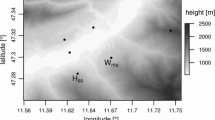Abstract
A system is described which is intended to calculate vertical fluxes of heat, moisture, momentum, and certain atmospheric pollutants at sites that are less than ideal. Fluxes, along with other turbulence statistics, are computed in real-time and printed at the end of each averaging period. The main elements of the program are (1) ‘detrending’ (by use of running mean removal), (2) calculation of the entire stress tensor (which allows a three-dimensional coordinate rotation to be performed on the covariances), (3) software-adjustable timing delays for each instrument channel, and (4) real-time graphic presentation of the raw data as stripchart images. The first two of these program elements tend to relax the normal site and sensor-leveling requirements. Sample results are presented, and the sensitivities of the calculated quantities to coordinate rotation and to mean removal time are examined for both ideal and non-ideal sites.
Similar content being viewed by others
References
Deacon, E. L.: ‘The Measurement of Turbulent Transfer in the Lower Atmosphere’, Adv. in Geophys. 6, 211–228.
Dyer, A. J.: 1975, ‘Measurement of Turbulent Fluxes by Fluxatron and NIFTI Techniques’, Atmos. Tech. 7, 24–29.
Dyer, A. J. and Hicks, B. B.: 1972, ‘The Spatial Variability of Eddy Fluxes in the Constant Flux Layer’, Quart. J. Roy. Meteorol. Soc. 98, 206–212.
Dyer, A. J. and Maher, F.: 1965, ‘The ‘Evapotron’: an Instrument for the Measurement of Eddy Fluxes in the Lower Atmosphere’, CSIRO Div. Met. Phys., Tech. Paper No. 15.
Dyer, A. J., Hicks, B. B., and King, K. M.: 1967, ‘The Fluxatron — a Revised Approach to the Measurement of Eddy Fluxes in the Lower Atmosphere’, J. Appl. Meteorol. 6, 408–413.
Enochson, L. D. and Otnes, R. K.: 1968, Programming and Analysis of Digital Time Series Data, The Shock and Vibration Information Center, U.S. Department of Defense, 277 pp.
Garber, R. W., Daum, P. H., Doering, R. F., D'Ottavio, T., and Tanner, R. L.: 1983, ‘Determination of Ambient Aerosol and Gaseous Sulfur Using a Continuous FPD-III. Design and Characterization of a Monitor for Airborne Applications’, Atmos. Environ. 17, 1381–1385.
Hicks, B. B.: 1972, ‘Propeller Anemometers as Sensors of Atmospheric Turbulence’, Boundary-Layer Meteorol. 3, 214–228.
Jarvis, P. G., James, G. B., and Landsberg, J. J.: 1976, ‘Coniferous Forest’, in J. L. Monteith (ed.), Vegetation and the Atmosphere, Vol. 2, Academic Press, New York. pp. 171–240.
Kaimal, J. C. and Haugen, D. A.: 1969, ‘Some Errors in the Measurements of Reynolds Stress’, J. Appl. Meteorol. 8, 460–462.
Kanemasu, E. T., Wesely, M. L., Hicks, B. B., and Heilman, J. L.: 1979, ‘Techniques for Calculating Energy and Mass Fluxes’, in B. J. Barfield and J. F. Gerber (eds.), Modification of the Aerial Environment of Crops, ASAE Monograph No. 2, American Society of Agricultural Engineers, St. Joseph, MO, U.S.A., pp. 156–182.
Kraus, E. B.: 1968, ‘What We Do Not Know about Sea-Surface Wind Stress’, Bull. Am. Meteorol. Soc. 49, 247–253.
Lloyd, C. R., Shuttelworth, W. J., Gash, J. H. C., and Turner, M.: 1984, ‘A Microprocessor System for Eddy-Correlation’, Agric. For. Meteorol. 33, 67–80.
McMillen, R. T.: 1983, ‘Eddy Correlation Calculations Done in Real-Time’, Preprints 16th Conference on Agricultural and Forest Meteorology, American Meteorological Society, Boston, pp. 111–113.
McMillen, R. T.: 1986, A BASIC Program for Eddy Correlation in Non-Simple Terrain, NOAA Tech. Memo. ERL ARL-147, NOAA Environmental Research Laboratories, Silver Spring, MD, 32 pp.
McMillen, R. T., Matt, D. R., Hicks, B. B., and Womack, J. D.: 1987, Dry Deposition Measurements of Sulfur Dioxide to a Spruce-Fir Forest in the Black Forest: A Data Report, NOAA Tech. Memo. ERL ARL-152, NOAA Environmental Research Laboratories, Silver Spring, MD, 66 pp.
Pond, S.: 1968, ‘Some Effects of Buoy Motion on Measurements of Wind Speed and Stress’, J. Geophys. Res. 73, 507–511.
Priestly, C. H. B.: 1959, ‘Estimation of Surface Stress and Heat Flux from Profile Data’, Quart. J. Roy. Meteorol. Soc. 85, 415–418.
Tajchman, S. J.: 1971, ‘Evapotranspiration and Energy Balances of Forest and Field’, Water Resour. Res. 7, 511–523.
Wesely, M. L.: 1970, ‘Eddy Correlation Measurements in the Atmospheric Surface Layer over Agricultural Crops’, Ph.D. Thesis, Univ. of Wisconsin, Madison, Wis., (Diss. Abstr. No. 70–24, 828), 102 pp.
Wyngaard, J. C.: 1981, ‘The Effects of Probe-Induced Flow Distortion on Atmospheric Turbulence Measurements’, J. Appl. Meteorol. 20, 784–794.
Author information
Authors and Affiliations
Rights and permissions
About this article
Cite this article
McMillen, R.T. An eddy correlation technique with extended applicability to non-simple terrain. Boundary-Layer Meteorol 43, 231–245 (1988). https://doi.org/10.1007/BF00128405
Revised:
Issue Date:
DOI: https://doi.org/10.1007/BF00128405




